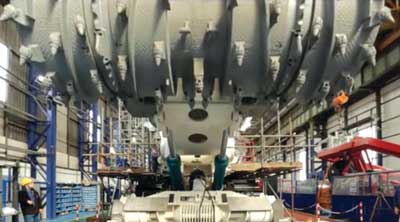 |
| Nautilus Minerals’ Bulk Cutter during factory assembly. |
Nautilus Minerals recently announced that assembly of the Bulk Cutter (BC), which is the first of its Seafloor Production Tools (SPTs), has been completed.
Toronto, Canada-based Nautilus was granted the first mining lease for polymetallic seafloor massive sulphide deposits at the prospect known as Solwara 1, in the territorial waters of Papua New Guinea, where it intends to produce copper, gold and silver. The company has also been granted its environmental permit for this site.
The BC is the heaviest of the three SPTs, weighing 310 mt when fully assembled. According to Nautilus, it is designed to be the high productivity machine responsible for the bulk of production.
The company said the cutting drum of the BC was designed and built by Sandvik (Austria), and its design is similar to those used on large continuous miner machines. The track sets for all three SPTs were designed and built by Caterpillar, based on an existing Caterpillar excavator track design. The dredge pumps for all three SPTs were supplied by Damen, a leading dredge equipment supplier, and are based on existing catalog designs used in the dredging industry.
The hydraulic equipment for all three SPTs utilizes off-the-shelf Bosch Rexroth hydraulic equipment, with adaptations by Soil Machine Dynamics Ltd. (SMD) of Newcastle upon Tyne, U.K., the company that is building the SPTs for Nautilus. The flexible hoses for all three SPTs were designed and supplied by ContiTech AG (Germany), and are very similar to the rubber hoses used in the dredging industry.
For seafloor mining, excavation and collection has been split into three individual tasks, which will each be carried out by a different vehicle. The Auxiliary Cutter is designed as the pioneering machine, which prepares the rugged seabed for the more powerful Bulk Cutter. These two machines gather the excavated material. The third vehicle, named the Collecting Machine, will collect the cut material by drawing it in as seawater slurry with internal pumps and pushing it thought a flexible pipe to the subsea pump and on to the production ship via a riser system.









